 The Battle of Pavia, fought on the morning of 24 February 1525, was the decisive engagement of the Italian War of 1521–26.
The Battle of Pavia, fought on the morning of 24 February 1525, was the decisive engagement of the Italian War of 1521–26.
A Spanish-Imperial army under the nominal command of Charles de Lannoy 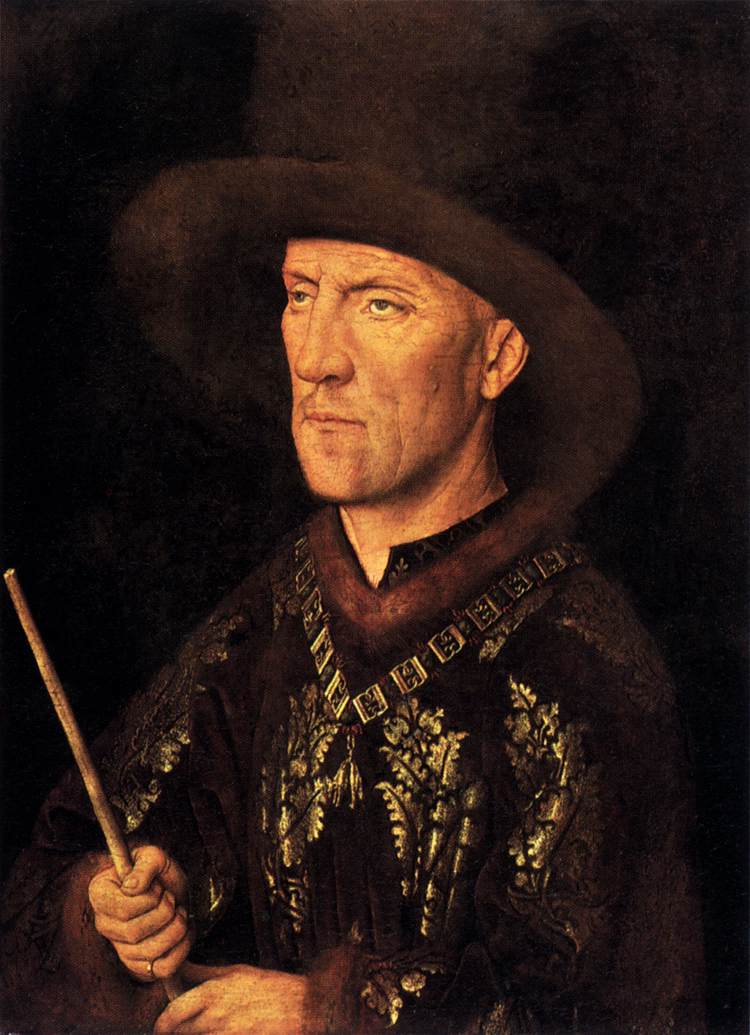 (and working in conjunction with the garrison of Pavia, commanded by Antonio de Leyva)
(and working in conjunction with the garrison of Pavia, commanded by Antonio de Leyva) attacked the French army under the personal command of Francis I
attacked the French army under the personal command of Francis I  of France in the great hunting preserve of Mirabello (Francis I (12 September 1494 – 31 March 1547) was King of France
of France in the great hunting preserve of Mirabello (Francis I (12 September 1494 – 31 March 1547) was King of France  from 1515 until his death. During his reign, huge cultural changes took place in France and he has been called
from 1515 until his death. During his reign, huge cultural changes took place in France and he has been called  France's original Renaissance monarch.His permanent rivalry with the Emperor Charles V for hegemony in Europe was the origin of a long and ruinous military conflict that gave rise to the Protestant revolution.
France's original Renaissance monarch.His permanent rivalry with the Emperor Charles V for hegemony in Europe was the origin of a long and ruinous military conflict that gave rise to the Protestant revolution.
 (and working in conjunction with the garrison of Pavia, commanded by Antonio de Leyva)
(and working in conjunction with the garrison of Pavia, commanded by Antonio de Leyva) attacked the French army under the personal command of Francis I
attacked the French army under the personal command of Francis I  of France in the great hunting preserve of Mirabello (Francis I (12 September 1494 – 31 March 1547) was King of France
of France in the great hunting preserve of Mirabello (Francis I (12 September 1494 – 31 March 1547) was King of France  from 1515 until his death. During his reign, huge cultural changes took place in France and he has been called
from 1515 until his death. During his reign, huge cultural changes took place in France and he has been called  France's original Renaissance monarch.His permanent rivalry with the Emperor Charles V for hegemony in Europe was the origin of a long and ruinous military conflict that gave rise to the Protestant revolution.
France's original Renaissance monarch.His permanent rivalry with the Emperor Charles V for hegemony in Europe was the origin of a long and ruinous military conflict that gave rise to the Protestant revolution.
Francis was an ally of Suleiman the Magnificent , with whom he formed the Franco-Ottoman alliance. His great rivals were King Henry VIII of England and Holy Roman Emperor Charles V).Francis died at the château de Rambouillet
, with whom he formed the Franco-Ottoman alliance. His great rivals were King Henry VIII of England and Holy Roman Emperor Charles V).Francis died at the château de Rambouillet on 31 March 1547, on his son and successor's 28th birthday. It is said that "he died complaining about the weight of a crown that he had first perceived as a gift from God"
on 31 March 1547, on his son and successor's 28th birthday. It is said that "he died complaining about the weight of a crown that he had first perceived as a gift from God".jpg) outside the city walls. In the four-hour battle, the French army was split and defeated in detail. The French suffered massive casualties,
outside the city walls. In the four-hour battle, the French army was split and defeated in detail. The French suffered massive casualties, including many of the chief nobles of France; Francis himself, captured by the Spanish troops, was imprisoned by Charles V
including many of the chief nobles of France; Francis himself, captured by the Spanish troops, was imprisoned by Charles V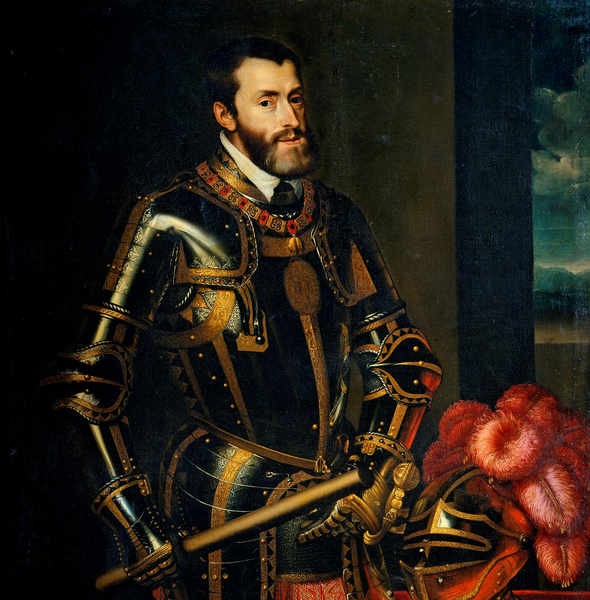 and forced to sign the humiliating Treaty of Madrid, surrendering significant territory to his captor. The outcome of the battle
and forced to sign the humiliating Treaty of Madrid, surrendering significant territory to his captor. The outcome of the battle  cemented Spanish Habsburg ascendancy in Italy.The French, in possession of Lombardy at the start of the Italian War of 1521–26,
cemented Spanish Habsburg ascendancy in Italy.The French, in possession of Lombardy at the start of the Italian War of 1521–26, had been forced to abandon it after their defeat at the Battle of Bicocca in 1522.The toponymy "Bicocca" is probably a reference to a villa that was built in 1450 and that was owned by the aristocratic family of theArcimboldi,
had been forced to abandon it after their defeat at the Battle of Bicocca in 1522.The toponymy "Bicocca" is probably a reference to a villa that was built in 1450 and that was owned by the aristocratic family of theArcimboldi,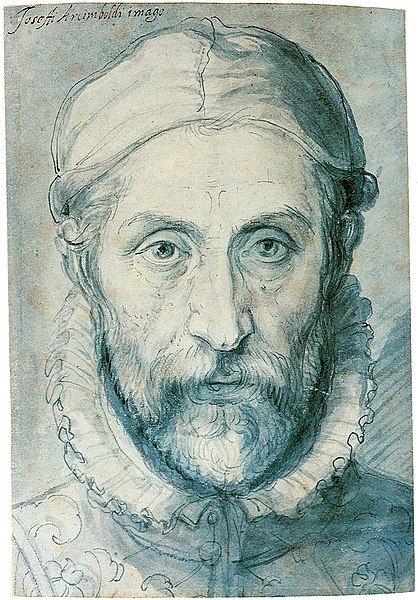 as the word "Bicocca" is an archaic term meaning "small castle located in an elevated place". The villa is still in place, and it is one of the landmarks of the Bicocca district.n the 19th century, the area of Bicocca was affected by a quick industrialization process, and was gradually absorbed into the urban agglomerate of Milan. It remained an autonomous comune until 1841, when it was annexed to Niguarda, which in turn became part of Milan in 1923.
as the word "Bicocca" is an archaic term meaning "small castle located in an elevated place". The villa is still in place, and it is one of the landmarks of the Bicocca district.n the 19th century, the area of Bicocca was affected by a quick industrialization process, and was gradually absorbed into the urban agglomerate of Milan. It remained an autonomous comune until 1841, when it was annexed to Niguarda, which in turn became part of Milan in 1923.
 Vicomte de Lautrec, was decisively defeated by aSpanish-Imperial and Papal army under the overall command of Prospero Colonna.
Vicomte de Lautrec, was decisively defeated by aSpanish-Imperial and Papal army under the overall command of Prospero Colonna.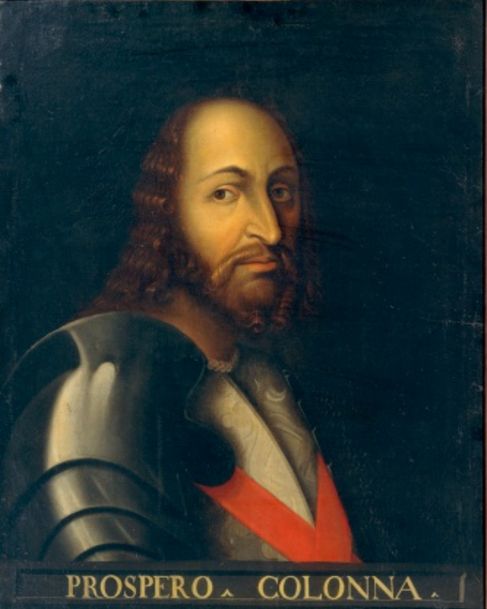 Lautrec then withdrew from Lombardy, leaving the Duchy of Milan in Imperial hands.
Lautrec then withdrew from Lombardy, leaving the Duchy of Milan in Imperial hands.
 . Determined to regain it, Francis ordered an invasion of the region in late 1523, under the command of Guillaume Gouffier, Seigneur de Bonnivet;
. Determined to regain it, Francis ordered an invasion of the region in late 1523, under the command of Guillaume Gouffier, Seigneur de Bonnivet;  but Bonnivet was defeated by Imperial troops at the Battle of the Sesia and forced to withdraw to France.
but Bonnivet was defeated by Imperial troops at the Battle of the Sesia and forced to withdraw to France.
 , with whom he formed the Franco-Ottoman alliance. His great rivals were King Henry VIII of England and Holy Roman Emperor Charles V).Francis died at the château de Rambouillet
, with whom he formed the Franco-Ottoman alliance. His great rivals were King Henry VIII of England and Holy Roman Emperor Charles V).Francis died at the château de Rambouillet on 31 March 1547, on his son and successor's 28th birthday. It is said that "he died complaining about the weight of a crown that he had first perceived as a gift from God"
on 31 March 1547, on his son and successor's 28th birthday. It is said that "he died complaining about the weight of a crown that he had first perceived as a gift from God".jpg) outside the city walls. In the four-hour battle, the French army was split and defeated in detail. The French suffered massive casualties,
outside the city walls. In the four-hour battle, the French army was split and defeated in detail. The French suffered massive casualties, including many of the chief nobles of France; Francis himself, captured by the Spanish troops, was imprisoned by Charles V
including many of the chief nobles of France; Francis himself, captured by the Spanish troops, was imprisoned by Charles V and forced to sign the humiliating Treaty of Madrid, surrendering significant territory to his captor. The outcome of the battle
and forced to sign the humiliating Treaty of Madrid, surrendering significant territory to his captor. The outcome of the battle  cemented Spanish Habsburg ascendancy in Italy.The French, in possession of Lombardy at the start of the Italian War of 1521–26,
cemented Spanish Habsburg ascendancy in Italy.The French, in possession of Lombardy at the start of the Italian War of 1521–26, had been forced to abandon it after their defeat at the Battle of Bicocca in 1522.The toponymy "Bicocca" is probably a reference to a villa that was built in 1450 and that was owned by the aristocratic family of theArcimboldi,
had been forced to abandon it after their defeat at the Battle of Bicocca in 1522.The toponymy "Bicocca" is probably a reference to a villa that was built in 1450 and that was owned by the aristocratic family of theArcimboldi, as the word "Bicocca" is an archaic term meaning "small castle located in an elevated place". The villa is still in place, and it is one of the landmarks of the Bicocca district.n the 19th century, the area of Bicocca was affected by a quick industrialization process, and was gradually absorbed into the urban agglomerate of Milan. It remained an autonomous comune until 1841, when it was annexed to Niguarda, which in turn became part of Milan in 1923.
as the word "Bicocca" is an archaic term meaning "small castle located in an elevated place". The villa is still in place, and it is one of the landmarks of the Bicocca district.n the 19th century, the area of Bicocca was affected by a quick industrialization process, and was gradually absorbed into the urban agglomerate of Milan. It remained an autonomous comune until 1841, when it was annexed to Niguarda, which in turn became part of Milan in 1923.
In 1552, the place was the setting of a famous battle between the Spanish of Charles V(Charles suffered from an enlarged lower jaw, a deformity that became considerably worse in later Habsburg generations, giving rise to the term Habsburg jaw . This deformity was caused by the family's long history of inbreeding, which was commonly practiced in royal families of that era to maintain dynastic control of territory. He struggled to chew his food properly and consequently experienced bad indigestion for much of his life. As a result, he usually ate alone.He suffered from epilepsy and was seriously afflicted with gout, presumably caused by a diet consisting mainly of red meat.As he aged, his gout progressed from painful to crippling. In his retirement, he was carried around the
. This deformity was caused by the family's long history of inbreeding, which was commonly practiced in royal families of that era to maintain dynastic control of territory. He struggled to chew his food properly and consequently experienced bad indigestion for much of his life. As a result, he usually ate alone.He suffered from epilepsy and was seriously afflicted with gout, presumably caused by a diet consisting mainly of red meat.As he aged, his gout progressed from painful to crippling. In his retirement, he was carried around the  monastery of St. Yuste in a sedan chair. A ramp was specially constructed to allow him easy access to his rooms)
monastery of St. Yuste in a sedan chair. A ramp was specially constructed to allow him easy access to his rooms) and the French of Francis I.
and the French of Francis I.
The Battle of Bicocca or La Bicocca (Italian: Battaglia della Bicocca) was fought on April 27, 1522, during the Italian War of 1521–26. A combined French and Venetian force under Odet de Foix, monastery of St. Yuste in a sedan chair. A ramp was specially constructed to allow him easy access to his rooms)
monastery of St. Yuste in a sedan chair. A ramp was specially constructed to allow him easy access to his rooms) and the French of Francis I.
and the French of Francis I. Vicomte de Lautrec, was decisively defeated by aSpanish-Imperial and Papal army under the overall command of Prospero Colonna.
Vicomte de Lautrec, was decisively defeated by aSpanish-Imperial and Papal army under the overall command of Prospero Colonna. Lautrec then withdrew from Lombardy, leaving the Duchy of Milan in Imperial hands.
Lautrec then withdrew from Lombardy, leaving the Duchy of Milan in Imperial hands.
Having been driven from Milan by an Imperial advance in late 1521, Lautrec had regrouped, attempting to strike at Colonna's lines of communication. When the Swiss mercenaries in French service did not receive their pay, however, they demanded an immediate battle,
in French service did not receive their pay, however, they demanded an immediate battle, (above The villa of the Arcimboldi (also known as "Bicocca degli Arcimboldi"), built in 1450, has been owned by several prominent families of the Milanese, and experienced a period of decay until it was restored in the early 20th century. From 1913 it became an experimental "open air school" for sick children. Carla Visconti di Modrone and Maria Pirelli greatly contributed to this project.
(above The villa of the Arcimboldi (also known as "Bicocca degli Arcimboldi"), built in 1450, has been owned by several prominent families of the Milanese, and experienced a period of decay until it was restored in the early 20th century. From 1913 it became an experimental "open air school" for sick children. Carla Visconti di Modrone and Maria Pirelli greatly contributed to this project.
 in French service did not receive their pay, however, they demanded an immediate battle,
in French service did not receive their pay, however, they demanded an immediate battle, (above The villa of the Arcimboldi (also known as "Bicocca degli Arcimboldi"), built in 1450, has been owned by several prominent families of the Milanese, and experienced a period of decay until it was restored in the early 20th century. From 1913 it became an experimental "open air school" for sick children. Carla Visconti di Modrone and Maria Pirelli greatly contributed to this project.
(above The villa of the Arcimboldi (also known as "Bicocca degli Arcimboldi"), built in 1450, has been owned by several prominent families of the Milanese, and experienced a period of decay until it was restored in the early 20th century. From 1913 it became an experimental "open air school" for sick children. Carla Visconti di Modrone and Maria Pirelli greatly contributed to this project.
In 1918 the villa was acquired by the Pirelli company, that had already established many facilities in the area.)and Lautrec was forced to attack Colonna's fortified position in the park of the Arcimboldi Villa Bicocca, (One of the surviving buildings of the historic Borgo Pirelli)north of Milan. The Swiss pikemen advanced over open fields under heavy artillery fire to assault the Imperial positions, but were halted at a sunken road backed by earthworks. Having suffered massive casualties from the fire of Spanish arquebusiers,
(One of the surviving buildings of the historic Borgo Pirelli)north of Milan. The Swiss pikemen advanced over open fields under heavy artillery fire to assault the Imperial positions, but were halted at a sunken road backed by earthworks. Having suffered massive casualties from the fire of Spanish arquebusiers, the Swiss retreated. Meanwhile, an attempt by French cavalry to flank Colonna's position proved equally ineffective. The Swiss, unwilling to fight further, marched off to their cantons a few days later, and Lautrec retreated into Venetian territory with the remnants of his army.
the Swiss retreated. Meanwhile, an attempt by French cavalry to flank Colonna's position proved equally ineffective. The Swiss, unwilling to fight further, marched off to their cantons a few days later, and Lautrec retreated into Venetian territory with the remnants of his army.
The battle is noted chiefly for marking the end of the Swiss dominance among the infantry of the Italian Wars, and of the Swiss method of assaults by massed columns of pikemen without support from other troops. It was simultaneously the first of a series of engagements which established the decisive role of firearms on the battlefield. (One of the surviving buildings of the historic Borgo Pirelli)north of Milan. The Swiss pikemen advanced over open fields under heavy artillery fire to assault the Imperial positions, but were halted at a sunken road backed by earthworks. Having suffered massive casualties from the fire of Spanish arquebusiers,
(One of the surviving buildings of the historic Borgo Pirelli)north of Milan. The Swiss pikemen advanced over open fields under heavy artillery fire to assault the Imperial positions, but were halted at a sunken road backed by earthworks. Having suffered massive casualties from the fire of Spanish arquebusiers, the Swiss retreated. Meanwhile, an attempt by French cavalry to flank Colonna's position proved equally ineffective. The Swiss, unwilling to fight further, marched off to their cantons a few days later, and Lautrec retreated into Venetian territory with the remnants of his army.
the Swiss retreated. Meanwhile, an attempt by French cavalry to flank Colonna's position proved equally ineffective. The Swiss, unwilling to fight further, marched off to their cantons a few days later, and Lautrec retreated into Venetian territory with the remnants of his army. . Determined to regain it, Francis ordered an invasion of the region in late 1523, under the command of Guillaume Gouffier, Seigneur de Bonnivet;
. Determined to regain it, Francis ordered an invasion of the region in late 1523, under the command of Guillaume Gouffier, Seigneur de Bonnivet;  but Bonnivet was defeated by Imperial troops at the Battle of the Sesia and forced to withdraw to France.
but Bonnivet was defeated by Imperial troops at the Battle of the Sesia and forced to withdraw to France.
Charles de Lannoy now launched an invasion of Provence under the command of Fernando d'Avalos, Marquess of Pescara, and Charles III, Duke of Bourbon (who had recently betrayed Francis and allied himself with the Emperor).
Marquess of Pescara, and Charles III, Duke of Bourbon (who had recently betrayed Francis and allied himself with the Emperor). While initially successful, the Imperial offensive lost valuable time during the Siege of Marseille and was forced to withdraw back to Italy by the arrival of Francis and the main French army at Avignon.
While initially successful, the Imperial offensive lost valuable time during the Siege of Marseille and was forced to withdraw back to Italy by the arrival of Francis and the main French army at Avignon.
 Marquess of Pescara, and Charles III, Duke of Bourbon (who had recently betrayed Francis and allied himself with the Emperor).
Marquess of Pescara, and Charles III, Duke of Bourbon (who had recently betrayed Francis and allied himself with the Emperor). While initially successful, the Imperial offensive lost valuable time during the Siege of Marseille and was forced to withdraw back to Italy by the arrival of Francis and the main French army at Avignon.
While initially successful, the Imperial offensive lost valuable time during the Siege of Marseille and was forced to withdraw back to Italy by the arrival of Francis and the main French army at Avignon.
In mid-October 1524, Francis himself crossed the Alps and advanced on Milan at the head of an army numbering more than 40,000. Bourbon and d'Avalos, their troops not yet recovered from the campaign in Provence,  were in no position to offer serious resistance. The French army moved in several columns, brushing aside Imperial attempts to hold its advance, but failed to bring the main body of Imperial troops to battle. Nevertheless, Charles de Lannoy,
were in no position to offer serious resistance. The French army moved in several columns, brushing aside Imperial attempts to hold its advance, but failed to bring the main body of Imperial troops to battle. Nevertheless, Charles de Lannoy, who had concentrated some 16,000 men to resist the 33,000 French troops closing on Milan, decided that the city could not be defended and withdrew to Lodi
who had concentrated some 16,000 men to resist the 33,000 French troops closing on Milan, decided that the city could not be defended and withdrew to Lodi on 26 October Having entered Milan and installed Louis II de la
on 26 October Having entered Milan and installed Louis II de la  Trémoille as the governor, Francis (at the urging of Bonnivet and against the advice of his other senior commanders, who favored a more vigorous pursuit
Trémoille as the governor, Francis (at the urging of Bonnivet and against the advice of his other senior commanders, who favored a more vigorous pursuit of the retreating Lannoy) advanced on Pavia, where Antonio de Leyva remained with a sizable Imperial garrison of about 9000.
of the retreating Lannoy) advanced on Pavia, where Antonio de Leyva remained with a sizable Imperial garrison of about 9000.
 were in no position to offer serious resistance. The French army moved in several columns, brushing aside Imperial attempts to hold its advance, but failed to bring the main body of Imperial troops to battle. Nevertheless, Charles de Lannoy,
were in no position to offer serious resistance. The French army moved in several columns, brushing aside Imperial attempts to hold its advance, but failed to bring the main body of Imperial troops to battle. Nevertheless, Charles de Lannoy, who had concentrated some 16,000 men to resist the 33,000 French troops closing on Milan, decided that the city could not be defended and withdrew to Lodi
who had concentrated some 16,000 men to resist the 33,000 French troops closing on Milan, decided that the city could not be defended and withdrew to Lodi on 26 October Having entered Milan and installed Louis II de la
on 26 October Having entered Milan and installed Louis II de la  Trémoille as the governor, Francis (at the urging of Bonnivet and against the advice of his other senior commanders, who favored a more vigorous pursuit
Trémoille as the governor, Francis (at the urging of Bonnivet and against the advice of his other senior commanders, who favored a more vigorous pursuit of the retreating Lannoy) advanced on Pavia, where Antonio de Leyva remained with a sizable Imperial garrison of about 9000.
of the retreating Lannoy) advanced on Pavia, where Antonio de Leyva remained with a sizable Imperial garrison of about 9000.
The main mass of French troops arrived at Pavia in the last days of October. By 2 November, Anne de Montmorency
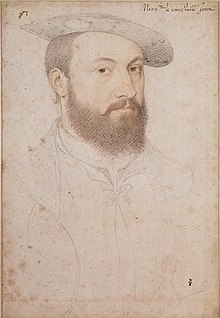 had crossed the Ticino River and invested the city from the south, completing its encirclement. Inside were about 9,000 men,
had crossed the Ticino River and invested the city from the south, completing its encirclement. Inside were about 9,000 men, mainly mercenaries whom Antonio de Leyva was able to pay only by melting the church plate. A period of skirmishing
mainly mercenaries whom Antonio de Leyva was able to pay only by melting the church plate. A period of skirmishing
and artillery bombardments followed, and several breaches had been made in the walls by mid-November.
 On 21 November, Francis attempted an assault on the city through two of the breaches, but was beaten back with
On 21 November, Francis attempted an assault on the city through two of the breaches, but was beaten back with heavy casualties; hampered by rainy weather and a lack of gunpowder, the French decided to wait for the defenders to starve.
heavy casualties; hampered by rainy weather and a lack of gunpowder, the French decided to wait for the defenders to starve.
In early December, a Spanish force commanded by Ugo de Moncada landed near Genoa, intending to interfere in a conflict between pro-Valois and pro-Habsburg factions in the city. Francis dispatched a larger force under the  Marquis of Saluzzo to intercept them. Confronted by the more numerous French and left without naval support by the arrival of a pro-Valois fleet commanded by Andrea Doria,
Marquis of Saluzzo to intercept them. Confronted by the more numerous French and left without naval support by the arrival of a pro-Valois fleet commanded by Andrea Doria, the Spanish troops surrendered. Francis then signed a secret agreement with Pope Clement VII, who pledged not to assist Charles in exchange for
the Spanish troops surrendered. Francis then signed a secret agreement with Pope Clement VII, who pledged not to assist Charles in exchange for Francis's assistance with the conquest of Naples. Against the advice of his senior commanders, Francis detached a portion of his forces under the Duke of Albany
Francis's assistance with the conquest of Naples. Against the advice of his senior commanders, Francis detached a portion of his forces under the Duke of Albany
 Marquis of Saluzzo to intercept them. Confronted by the more numerous French and left without naval support by the arrival of a pro-Valois fleet commanded by Andrea Doria,
Marquis of Saluzzo to intercept them. Confronted by the more numerous French and left without naval support by the arrival of a pro-Valois fleet commanded by Andrea Doria, the Spanish troops surrendered. Francis then signed a secret agreement with Pope Clement VII, who pledged not to assist Charles in exchange for
the Spanish troops surrendered. Francis then signed a secret agreement with Pope Clement VII, who pledged not to assist Charles in exchange for
and sent them south to aid the Pope.Lannoy attempted to intercept the expedition near Fiorenzuola, 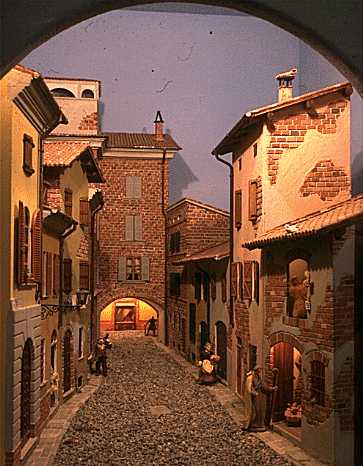 but suffered heavy casualties and was forced to return to Lodi by the intervention of the infamous Black Bands
but suffered heavy casualties and was forced to return to Lodi by the intervention of the infamous Black Bands  of Giovanni de' Medici, Italian mercenaries which had just entered French service. Medici then returned to Pavia with a supply train of gunpowder and shot gathered by the Duke of Ferrara; but the French position was simultaneously weakened by the departure of nearly 5,000 Grisons Swiss mercenaries, who returned to their cantons in order to defend them against maraudinglandsknechts.
of Giovanni de' Medici, Italian mercenaries which had just entered French service. Medici then returned to Pavia with a supply train of gunpowder and shot gathered by the Duke of Ferrara; but the French position was simultaneously weakened by the departure of nearly 5,000 Grisons Swiss mercenaries, who returned to their cantons in order to defend them against maraudinglandsknechts.
In January 1525, Lannoy was reinforced by the arrival of Georg Frundsberg with 15,000 fresh landsknechts and renewed the offensive. D'Avalos captured the French outpost at Sant'Angelo,  cutting the lines of communication between Pavia and Milan, while a separate column of landsknechts advanced onBelgiojoso
cutting the lines of communication between Pavia and Milan, while a separate column of landsknechts advanced onBelgiojoso and, despite being briefly pushed back by a raid led by Medici and Bonnivet, occupied the town. By 2 February, Lannoy was only a few miles from Pavia. Francis had encamped the majority of his forces in the great walled park of Mirabello outside the city walls, placing them between Leyva's garrison and the approaching relief army.Skirmishing and sallies by the garrison continued through the month of February. Medici was seriously wounded and withdrew to Piacenza to recuperate
and, despite being briefly pushed back by a raid led by Medici and Bonnivet, occupied the town. By 2 February, Lannoy was only a few miles from Pavia. Francis had encamped the majority of his forces in the great walled park of Mirabello outside the city walls, placing them between Leyva's garrison and the approaching relief army.Skirmishing and sallies by the garrison continued through the month of February. Medici was seriously wounded and withdrew to Piacenza to recuperate , forcing Francis to recall much of the Milan garrison to offset the departure of the Black Band; but the fighting had little overall effect. On 21 February, the Imperial commanders, running low on supplies and mistakenly believing that the French forces were more numerous than their own, decided to launch an attack on Mirabello Castle in order to save face and demoralize the French sufficiently to ensure a safe withdrawal.
, forcing Francis to recall much of the Milan garrison to offset the departure of the Black Band; but the fighting had little overall effect. On 21 February, the Imperial commanders, running low on supplies and mistakenly believing that the French forces were more numerous than their own, decided to launch an attack on Mirabello Castle in order to save face and demoralize the French sufficiently to ensure a safe withdrawal.
On the evening of 23 February, Lannoy's imperial troops, which had been encamped outside the east wall of the park, began their march north along the walls. At the same time, the Imperial artillery began a bombardment of the French siege lines— which had become routine during the extended siege—in order to conceal Lannoy's movement. Meanwhile, Imperial engineers quickly worked to create a breach in the park walls,
which had become routine during the extended siege—in order to conceal Lannoy's movement. Meanwhile, Imperial engineers quickly worked to create a breach in the park walls, Porta Pescarina at the Porta Pescarina near the village of San Genesio,
Porta Pescarina at the Porta Pescarina near the village of San Genesio, through which the Imperial army could enter. By 5:00 in the morning, some 3,000 arquebusiers under the command of Alfonso d'Avalos
through which the Imperial army could enter. By 5:00 in the morning, some 3,000 arquebusiers under the command of Alfonso d'Avalos had entered the park and were rapidly advancing on Mirabello Castle, where they believed the French headquarters to be; simultaneously,
had entered the park and were rapidly advancing on Mirabello Castle, where they believed the French headquarters to be; simultaneously, 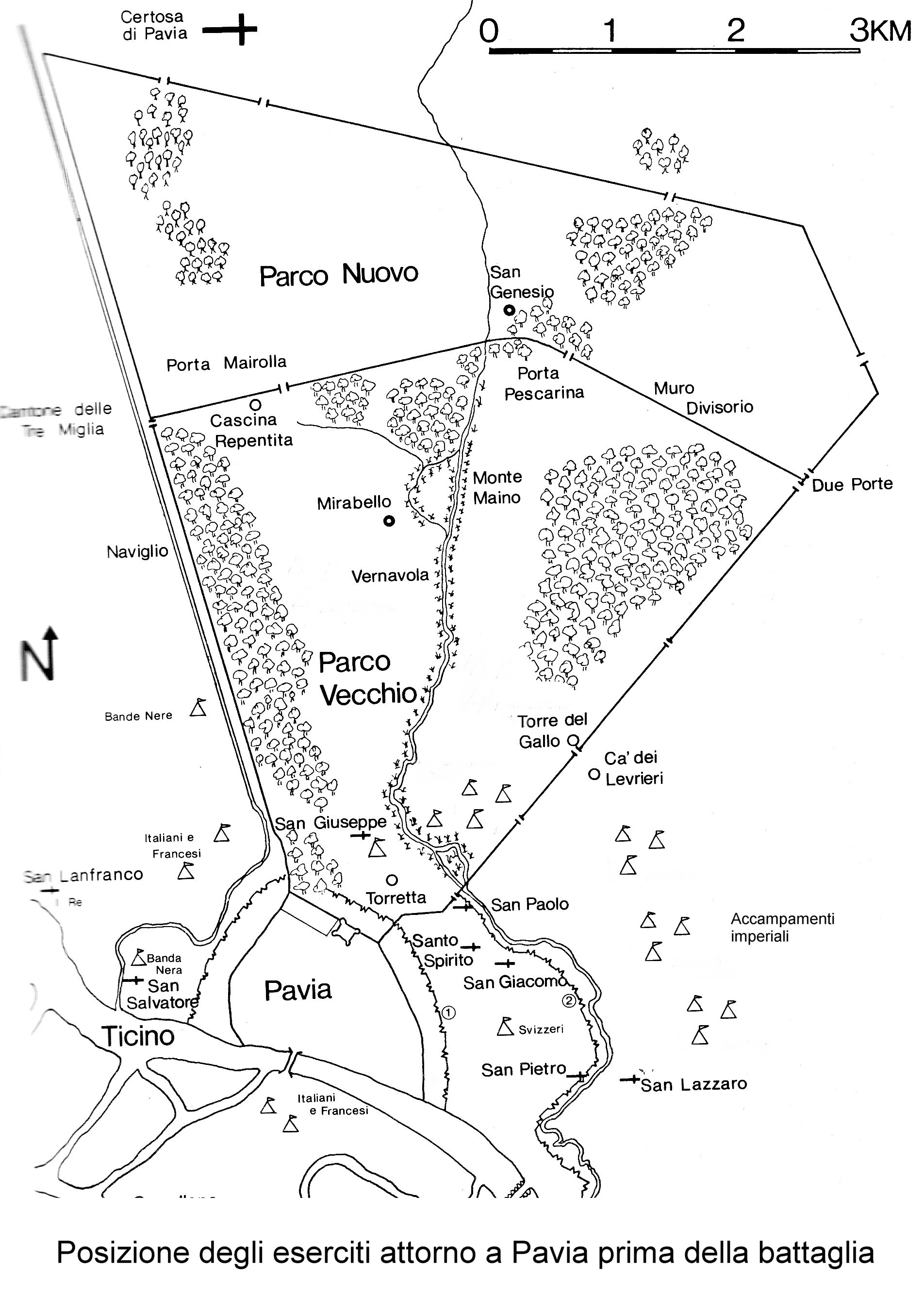 Imperial light cavalry spread out from the breach into the park, intending to intercept any French movements.
Imperial light cavalry spread out from the breach into the park, intending to intercept any French movements.
 which had become routine during the extended siege—in order to conceal Lannoy's movement. Meanwhile, Imperial engineers quickly worked to create a breach in the park walls,
which had become routine during the extended siege—in order to conceal Lannoy's movement. Meanwhile, Imperial engineers quickly worked to create a breach in the park walls, Porta Pescarina at the Porta Pescarina near the village of San Genesio,
Porta Pescarina at the Porta Pescarina near the village of San Genesio, through which the Imperial army could enter. By 5:00 in the morning, some 3,000 arquebusiers under the command of Alfonso d'Avalos
through which the Imperial army could enter. By 5:00 in the morning, some 3,000 arquebusiers under the command of Alfonso d'Avalos had entered the park and were rapidly advancing on Mirabello Castle, where they believed the French headquarters to be; simultaneously,
had entered the park and were rapidly advancing on Mirabello Castle, where they believed the French headquarters to be; simultaneously,  Imperial light cavalry spread out from the breach into the park, intending to intercept any French movements.
Imperial light cavalry spread out from the breach into the park, intending to intercept any French movements.
Meanwhile, a detachment of French cavalry under Charles Tiercelin encountered the Imperial cavalry and began a series of skirmishes with them. A mass of Swiss pikemen under Robert de la Marck, Seigneur de la Flourance moved up to assist them, overrunning a battery of Spanish artillery that had been dragged into the park.They missed De Vasto's arquebusiers—who had, by 6:30, emerged from the woods near the castle and swiftly overrun it—and blundered into 6,000 of Georg Frundsberg's landsknechts. By 7:00, a full-scale infantry battle had developed not far from the original breach.]
Seigneur de la Flourance moved up to assist them, overrunning a battery of Spanish artillery that had been dragged into the park.They missed De Vasto's arquebusiers—who had, by 6:30, emerged from the woods near the castle and swiftly overrun it—and blundered into 6,000 of Georg Frundsberg's landsknechts. By 7:00, a full-scale infantry battle had developed not far from the original breach.]
 Seigneur de la Flourance moved up to assist them, overrunning a battery of Spanish artillery that had been dragged into the park.They missed De Vasto's arquebusiers—who had, by 6:30, emerged from the woods near the castle and swiftly overrun it—and blundered into 6,000 of Georg Frundsberg's landsknechts. By 7:00, a full-scale infantry battle had developed not far from the original breach.]
Seigneur de la Flourance moved up to assist them, overrunning a battery of Spanish artillery that had been dragged into the park.They missed De Vasto's arquebusiers—who had, by 6:30, emerged from the woods near the castle and swiftly overrun it—and blundered into 6,000 of Georg Frundsberg's landsknechts. By 7:00, a full-scale infantry battle had developed not far from the original breach.]
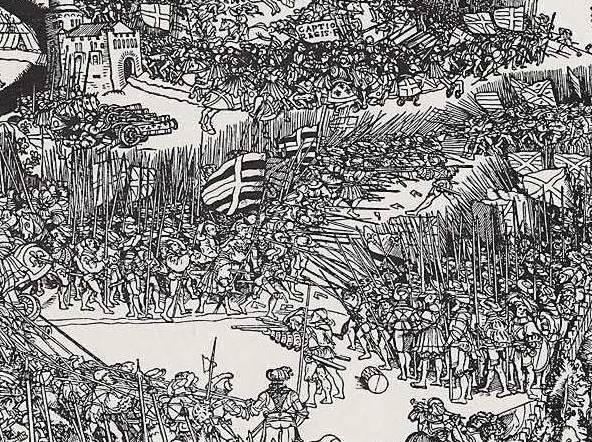 d'Avalos's advance had been spotted by a battery of French artillery, which commenced firing at the Spanish lines. This alerted Francis, who launched a charge against Lannoy's outnumbered cavalry with the entire force of French gendarmes, scattering the Spanish by 7:40.
d'Avalos's advance had been spotted by a battery of French artillery, which commenced firing at the Spanish lines. This alerted Francis, who launched a charge against Lannoy's outnumbered cavalry with the entire force of French gendarmes, scattering the Spanish by 7:40.!fOBP0vr,8JDw~~60_12.JPG)
Francis's precipitate advance, however, had not only masked the fire of the French artillery, but also pulled him away from the mass of French infantry, commanded by Richard de la Pole. La Pole (1480 - 24 February 1525) 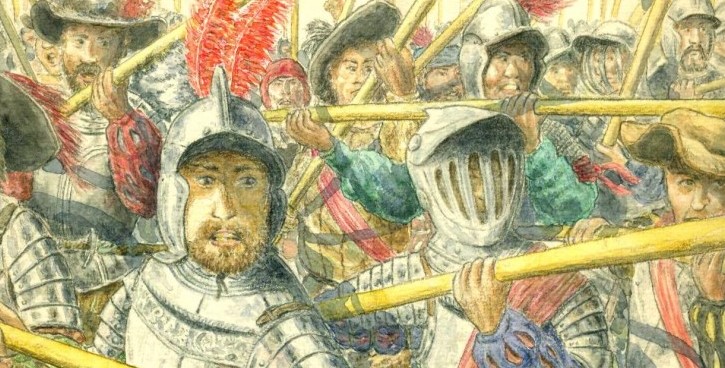 was a pretender to the English crown. Commonly nicknamed White Rose, he was the last member of the House of York to actively and openly seek the crown of England. He lived in exile after many of his relatives were executed; here he became allied with Louis XII of France in the War of the League of Cambrai, who saw him as a more favourable ally and prospect for an English king than Henry VIII.
was a pretender to the English crown. Commonly nicknamed White Rose, he was the last member of the House of York to actively and openly seek the crown of England. He lived in exile after many of his relatives were executed; here he became allied with Louis XII of France in the War of the League of Cambrai, who saw him as a more favourable ally and prospect for an English king than Henry VIII.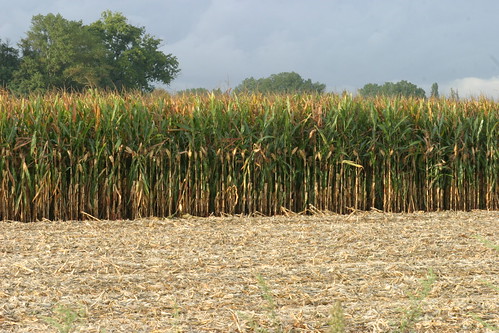
 was a pretender to the English crown. Commonly nicknamed White Rose, he was the last member of the House of York to actively and openly seek the crown of England. He lived in exile after many of his relatives were executed; here he became allied with Louis XII of France in the War of the League of Cambrai, who saw him as a more favourable ally and prospect for an English king than Henry VIII.
was a pretender to the English crown. Commonly nicknamed White Rose, he was the last member of the House of York to actively and openly seek the crown of England. He lived in exile after many of his relatives were executed; here he became allied with Louis XII of France in the War of the League of Cambrai, who saw him as a more favourable ally and prospect for an English king than Henry VIII.
The War of the League of Cambrai, sometimes known as the War of the Holy League and by several other names,was a major conflict in the Italian Wars. The principal participants of the war, which was fought from 1508 to 1516, wereFrance, the Papal States and the Republic of Venice; they were joined, at various times, by nearly every significant power in Western Europe, including Spain, the Holy Roman Empire, England, Scotland, the Duchy of Milan, Florence, the Duchy of Ferrara, and Swiss mercenaries.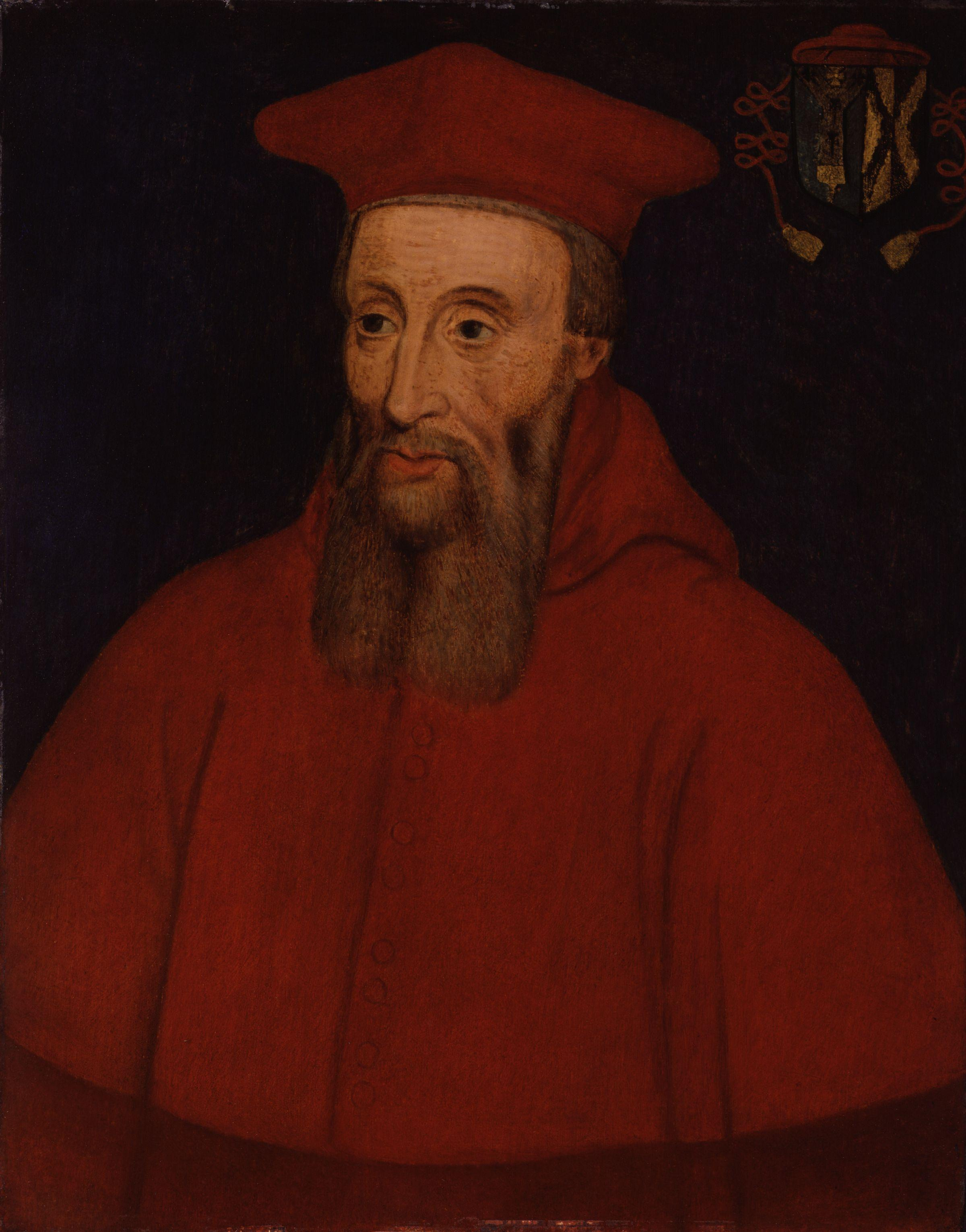 , and by Francois de Lorraine
, and by Francois de Lorraine , who led the Black Band of renegade Landsknecht pikemen (not to be confused with the Italian mercenary company of arquebusiers by the same name), which was 4,000 to 5,000 men strong. D'Avalos, left in command of the Spanish forces after Lannoy had followed the retreating cavalry, formed his men up at the edge of the woods and sent messengers to Bourbon, Frundsberg, and De Vasto requesting assistance.
, who led the Black Band of renegade Landsknecht pikemen (not to be confused with the Italian mercenary company of arquebusiers by the same name), which was 4,000 to 5,000 men strong. D'Avalos, left in command of the Spanish forces after Lannoy had followed the retreating cavalry, formed his men up at the edge of the woods and sent messengers to Bourbon, Frundsberg, and De Vasto requesting assistance.
 , and by Francois de Lorraine
, and by Francois de Lorraine
Frundsberg had meanwhile mauled the heavily outnumbered Swiss infantry opposing him; Tiercelin and Flourance were unable to hold their troops together, and the French foot began to flee the field.
By 8:00, a mass of Imperial pikemen and arquebusiers descended on the French cavalry from all sides. Lacking room to maneuver by the surrounding woods, the French gendarmes were surrounded and systematically killed. Richard de la Pole and Lorraine, advancing to assist Francis, were met by Frundsberg's arriving landsknechts; the French infantry was broken and routed, and de la Pole and Lorraine were both killed. In a particularly bitter contest between Imperial and renegade Landsknechts, the Black Band was surrounded by Frundsberg's pikemen and exterminated where it stood. The French king fought on as his horse was killed from under him by Cesare Hercolani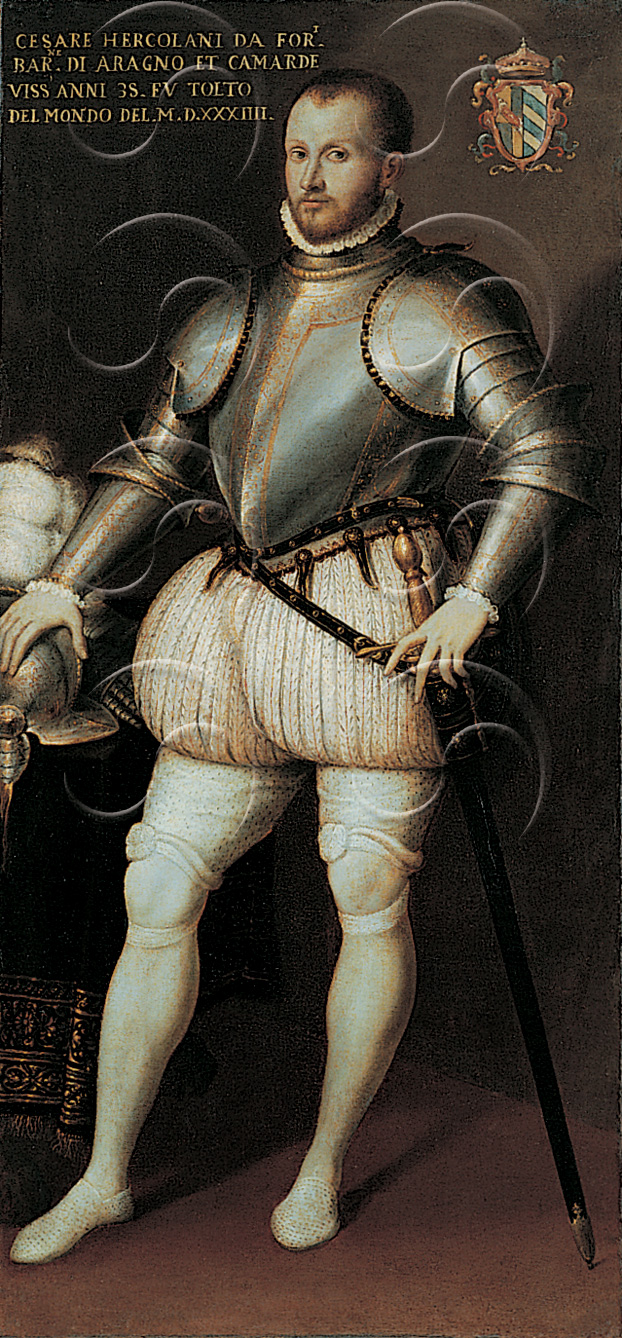 , an Italian Condottiere.;surrounded by Spanish arquebusiers, he was taken prisoner and escorted from the field
, an Italian Condottiere.;surrounded by Spanish arquebusiers, he was taken prisoner and escorted from the field
 , an Italian Condottiere.;surrounded by Spanish arquebusiers, he was taken prisoner and escorted from the field
, an Italian Condottiere.;surrounded by Spanish arquebusiers, he was taken prisoner and escorted from the field
The exact nature of Francis's surrender—in particular, who exactly had taken him prisoner—is uncertain, with a variety of candidates ranging from Alonso Pita da Veiga, Juan de Urbieta
Juan de Urbieta  and Diego Dávila to Lannoy himself being put forward by various historians. The fact of the matter was that, as documented in the article for Alonso Pita da Veiga, at the time, no single
and Diego Dávila to Lannoy himself being put forward by various historians. The fact of the matter was that, as documented in the article for Alonso Pita da Veiga, at the time, no single 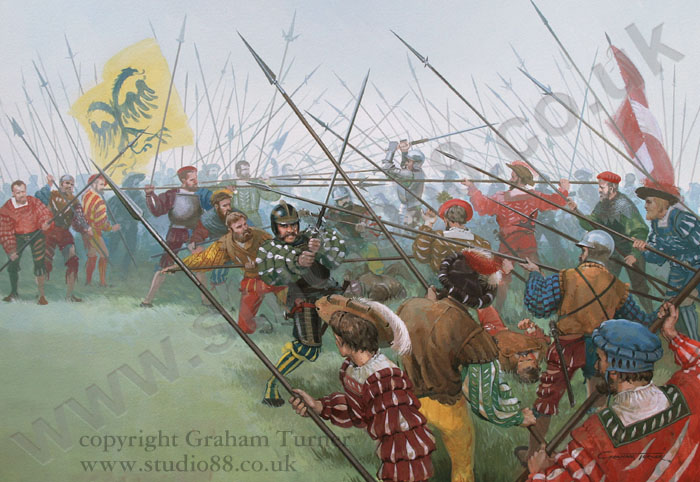 individual was given credit for the capture of Francis I. The decree granting a coat of arms to Alonso Pita da Veiga for his deeds at the Battle of Pavia, was archived at the General Archive of Simanca (Archivo general de Simancas, legajo 388, rotulado de "Mercedes y Privilegios.’) and was issued by Emperor Charles V on 24 July 1529.
individual was given credit for the capture of Francis I. The decree granting a coat of arms to Alonso Pita da Veiga for his deeds at the Battle of Pavia, was archived at the General Archive of Simanca (Archivo general de Simancas, legajo 388, rotulado de "Mercedes y Privilegios.’) and was issued by Emperor Charles V on 24 July 1529. In that decree, Charles V does not credit a single individual but, rather, a group of individuals that included Alonso Pita da Veiga: " ..... and in the same battle, you (Alonso Pita da Veiga) accomplished so much that you reached the person of said King (Francis I of France) and captured him, jointly with the other persons that captured him.” (" .... y en la misma batalla ficistes tanto que allegastes á la misma persona del dicho Rey, y fuistes en prenderle, juntamente con las otras personas que le prendieron ....")
In that decree, Charles V does not credit a single individual but, rather, a group of individuals that included Alonso Pita da Veiga: " ..... and in the same battle, you (Alonso Pita da Veiga) accomplished so much that you reached the person of said King (Francis I of France) and captured him, jointly with the other persons that captured him.” (" .... y en la misma batalla ficistes tanto que allegastes á la misma persona del dicho Rey, y fuistes en prenderle, juntamente con las otras personas que le prendieron ....")
 Juan de Urbieta
Juan de Urbieta  and Diego Dávila to Lannoy himself being put forward by various historians. The fact of the matter was that, as documented in the article for Alonso Pita da Veiga, at the time, no single
and Diego Dávila to Lannoy himself being put forward by various historians. The fact of the matter was that, as documented in the article for Alonso Pita da Veiga, at the time, no single  individual was given credit for the capture of Francis I. The decree granting a coat of arms to Alonso Pita da Veiga for his deeds at the Battle of Pavia, was archived at the General Archive of Simanca (Archivo general de Simancas, legajo 388, rotulado de "Mercedes y Privilegios.’) and was issued by Emperor Charles V on 24 July 1529.
individual was given credit for the capture of Francis I. The decree granting a coat of arms to Alonso Pita da Veiga for his deeds at the Battle of Pavia, was archived at the General Archive of Simanca (Archivo general de Simancas, legajo 388, rotulado de "Mercedes y Privilegios.’) and was issued by Emperor Charles V on 24 July 1529. In that decree, Charles V does not credit a single individual but, rather, a group of individuals that included Alonso Pita da Veiga: " ..... and in the same battle, you (Alonso Pita da Veiga) accomplished so much that you reached the person of said King (Francis I of France) and captured him, jointly with the other persons that captured him.” (" .... y en la misma batalla ficistes tanto que allegastes á la misma persona del dicho Rey, y fuistes en prenderle, juntamente con las otras personas que le prendieron ....")
In that decree, Charles V does not credit a single individual but, rather, a group of individuals that included Alonso Pita da Veiga: " ..... and in the same battle, you (Alonso Pita da Veiga) accomplished so much that you reached the person of said King (Francis I of France) and captured him, jointly with the other persons that captured him.” (" .... y en la misma batalla ficistes tanto que allegastes á la misma persona del dicho Rey, y fuistes en prenderle, juntamente con las otras personas que le prendieron ....")
Meanwhile, Antonio de Leyva had sortied with the garrison, overrunning the 3,000 Swiss under Montmorency that had been manning the siege lines. The remnants of the Swiss–both Montmorency's  and Flourance's—tried to flee across the river, suffering massive casualties as they did. The French rearguard, under the Duke of
and Flourance's—tried to flee across the river, suffering massive casualties as they did. The French rearguard, under the Duke of  Alençon, had taken no part in the battle; when the Duke realized what had occurred in the park, he quickly began to retreat towards Milan. By 9:00 in the morning, the battle was over.
Alençon, had taken no part in the battle; when the Duke realized what had occurred in the park, he quickly began to retreat towards Milan. By 9:00 in the morning, the battle was over.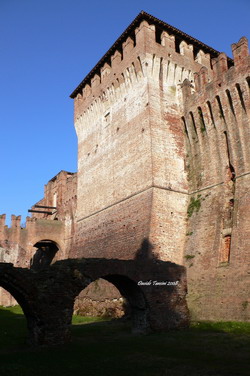
 and Flourance's—tried to flee across the river, suffering massive casualties as they did. The French rearguard, under the Duke of
and Flourance's—tried to flee across the river, suffering massive casualties as they did. The French rearguard, under the Duke of  Alençon, had taken no part in the battle; when the Duke realized what had occurred in the park, he quickly began to retreat towards Milan. By 9:00 in the morning, the battle was over.
Alençon, had taken no part in the battle; when the Duke realized what had occurred in the park, he quickly began to retreat towards Milan. By 9:00 in the morning, the battle was over.
The French defeat was decisive. Aside from Francis, a number of leading French nobles— including Montmorency and Flourance—had been captured; an even greater number—among them Bonnivet, Le Tremoille
including Montmorency and Flourance—had been captured; an even greater number—among them Bonnivet, Le Tremoille , La Palice,
, La Palice,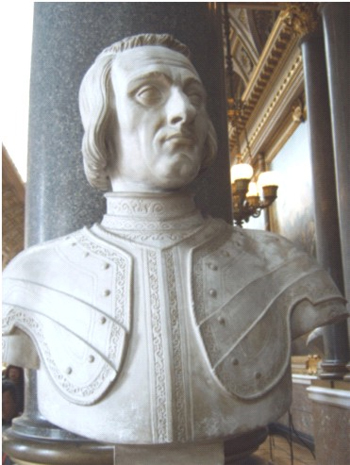 de la Pole, and Lorraine—had been killed in the fighting. Francis was taken to the fortress of Pizzighettone
de la Pole, and Lorraine—had been killed in the fighting. Francis was taken to the fortress of Pizzighettone , where he penned his famous letter to Louise of Savoy, his mother:
, where he penned his famous letter to Louise of Savoy, his mother:
 including Montmorency and Flourance—had been captured; an even greater number—among them Bonnivet, Le Tremoille
including Montmorency and Flourance—had been captured; an even greater number—among them Bonnivet, Le Tremoille , La Palice,
, La Palice, de la Pole, and Lorraine—had been killed in the fighting. Francis was taken to the fortress of Pizzighettone
de la Pole, and Lorraine—had been killed in the fighting. Francis was taken to the fortress of Pizzighettone , where he penned his famous letter to Louise of Savoy, his mother:
, where he penned his famous letter to Louise of Savoy, his mother:
| “ | To inform you of how the rest of my ill-fortune is proceeding, all is lost to me save honour and life, which is safe... | ” |
Soon afterwards, he finally learned that the Duke of Albany had lost the larger part of his army to attrition and desertion, and had returned to France without ever having reached Naples.The broken remnants of the French forces, aside from a small garrison left to hold the Castel Sforzesco in Milan, retreated across the Alps under the nominal command of Charles IV of Alençon, reaching Lyon by March.
Naples.The broken remnants of the French forces, aside from a small garrison left to hold the Castel Sforzesco in Milan, retreated across the Alps under the nominal command of Charles IV of Alençon, reaching Lyon by March.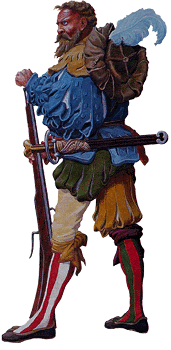
 Naples.The broken remnants of the French forces, aside from a small garrison left to hold the Castel Sforzesco in Milan, retreated across the Alps under the nominal command of Charles IV of Alençon, reaching Lyon by March.
Naples.The broken remnants of the French forces, aside from a small garrison left to hold the Castel Sforzesco in Milan, retreated across the Alps under the nominal command of Charles IV of Alençon, reaching Lyon by March.
above This detail of the overrun French camp at Pavia shows tent posts remaining upright event though two have snapped off several feet above the ground and the others' guy ropes are unstaked and hanging loose. Evidently they were sunk into holes and fixed straight upright by driving in stakes around the base.

Charles V enthroned over his defeated enemies Giulio Clovio mid 16th century.
This helps explain the very thick pavilion poles seen in many Italian paintings.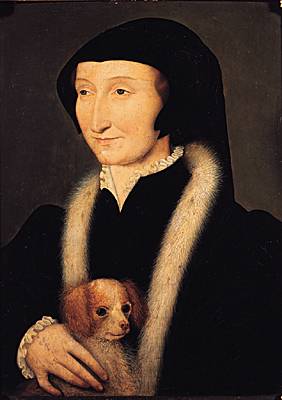
An oil-on-panel Battle of Pavia, painted by an anonymous Flemish artist, depicts the military engagement between the armies of Charles V and Francis I. Because of its detail, the painting is considered an accurate visual record, probably based on eyewitness  accounts.A suite of seven Brussels tapestries after cartoons by Bernard van Orley
accounts.A suite of seven Brussels tapestries after cartoons by Bernard van Orley (left) celebrate the Hapsburg victory.
(left) celebrate the Hapsburg victory.
 accounts.A suite of seven Brussels tapestries after cartoons by Bernard van Orley
accounts.A suite of seven Brussels tapestries after cartoons by Bernard van Orley (left) celebrate the Hapsburg victory.
(left) celebrate the Hapsburg victory.
Il miccone pavese, o miccone di Stradella, è un pane che dura nel tempo e può essere tranquillamente consumato anche qualche giorno dopo l’acquisto, a differenza di molti suoi 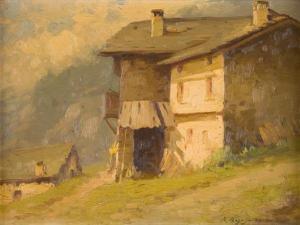 cugini forse più moderni, ma che hanno il triste difetto di risultare immangiabili nel giro di 24 ore dall’uscita dal forno.
cugini forse più moderni, ma che hanno il triste difetto di risultare immangiabili nel giro di 24 ore dall’uscita dal forno.
 cugini forse più moderni, ma che hanno il triste difetto di risultare immangiabili nel giro di 24 ore dall’uscita dal forno.
cugini forse più moderni, ma che hanno il triste difetto di risultare immangiabili nel giro di 24 ore dall’uscita dal forno.
Questa caratteristica è probabilmente legata alle abitudini delle campagne e delle colline pavesi, in cui il pane veniva preparato una volta alla settimana e doveva essere in grado di affrontare senza timori il trascorrere del tempo.

Che cos’è il miccone pavese
Tipico prodotto dell’Oltrepò, è diffuso e facilmente reperibile in tutta la provincia di Pavia. Si tratta di una grossa forma di pane bianco che si esalta in abbinamento con i salumi tipici delle nostre zone, dal salame di Varzi alla pancetta pavese, alla coppa, per citarne alcuni. Inoltre, la sua crosta spessa e l’abbondante mollica bianca e morbida si prestano ottimamente a essere “pucciate” in sughi e intingoli di ogni genere.

Viene preparato con farina di grano tenero, acqua, sale e lievito e venduto in pagnotte che pesano attorno ai 7 etti; ne esistono anche varianti che prevedono l’aggiunta di strutto. La cura nella lavorazione è indispensabile per sfornare un pane che risponda alle caratteristiche del miccone. È necessario lavorare a lungo l’impasto, quindi farlo lievitare, preparare le forme, poi lasciarle lievitare ancora. Le forme vengono incise nella parte superiore per dare loro l’aspetto tipico di questo pane.

Lo scopo di questa procedura è ottenere un pane che contenga poca umidità e che possa conservarsi a lungo anche in zone, come la provincia di Pavia, dove certo non manca l’umidità nell’aria, come ben sappiamo noi pavesi…

Il miccone: prodotto agroalimentare tradizionale
Il miccone rientra nell’elenco dei prodotti agroalimentari tipici della Regione Lombardia assieme ad altri prodotti da forno e da pasticceria della provincia di Pavia, come il pane giallo e i baci del signore.
No comments:
Post a Comment